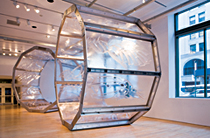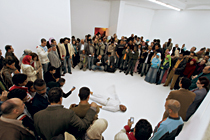17 things you need to know when you are a 17-year-old student who wants to become an artist, with a reminder for ways teachers can help!
- Tell students they can be artists. It is an honorable job and one that contributes to our culture. Help them get access to everything; access is the most important thing. Encourage students to be artists—this is very important.
- Access reading lists—books to read to stimulate
growth and understanding. Read everything! Look things up online, then
go to the library; libraries are extraordinary places to visit. Try
these to start:
- The 20th Century Art Book (Phaidon) by editors of Phaidon Press
- From Margin to Center: The Spaces of Installation Art by Julie H. Reiss
- Gardner’s Art through the Ages, volume I, chapters 1–18 (with ArtStudy Student CD-ROM and InfoTrac ) (paperback)
- German Expressionism: Art and Society by Stephanie Barron
- Impressionism (World of Art) by Phoebe Pool
- Pop Art (World of Art) by Lucy R. Lippard
- Post-Impressionism (World of Art) by Bernard Denvir
- The Expressionists (World of Art) by Wolf-Dieter Dube
- A Room in the Museum of Modern Art in Frankfurt/Main by Bettina Rheims
- POPism: The Warhol Sixties by Andy Warhol and Pat Hackett
- Access art classes—either after school or summer programs or at home. Ask your teachers to suggest junior colleges or community centers, any place you can go to learn about art. Try subscribing to news from Art&Education.
- Access maps of art museums and art galleries. Get on the metro and check these venues and more. Get there any way you can. Most museums have a free day once a week—take advantage of this. Art galleries are always free; go often and see everything.
- Access information about the historical and cultural impact of artists and art movements.the art:21 Web site and register to get their newsletter. Find a contemporary art history class. There are many museums and universities that have free lectures on contemporary artists. Start with the 20th century, then expand back in history. Check out
- Expose students to documentaries and other information about the education system. How do you go to art school or to the university? Find the counselor in your high school; ask about art schools and university art programs.
- FIND ART MATERIALS! Get your hands on ANYTHING you can use to make art: used gear, paints, cameras, etc. You don’t need a lot of money to start off, but where do you start? Teachers, tell students where to start.
- Be a part of the digital age: Web sites, blogs, e-mail lists. If you can’t physically get there, see it electronically. Link me up! Read the Modern Art Notes blog.
- Explore film: As visual artists, there are films
that we HAVE TO WATCH. Foreign films, domestic films, documentaries.
There are so many “top 10″ foreign films. I strongly recommend:
- Ciao, Professore! (Italy)
- Kolya (Czechoslovakia)
- El Mariachi (Mexico)
- Maria Full of Grace (Colombia)
- Das Experiment (Germany)
- The Bicycle Thief (Italy)
- City of God (Brazil)
- French Twist (France)
- Run Lola Run (Germany)
- Secret Things (France)
- You go to college to train, learn, grow, and be exposed to new ideas, not to get a job. Teachers, explain how and why this works, and how best to make a game plan to take advantage of what is offered. Tell the students about the schools that exist. Encourage higher education at every possible moment and repeat it over and over.
- You need to work 10 times harder because you have to.
- You have to be proactive in your education and keep your eye on the ball at all times.
- Make the most of your time every day of your life. Work hard on your personal growth, read poetry, look at art, read literature, and expose yourself to cultural events of all kinds. Listen to music, attend performances, see theater, and look at art all the time.
- Go beyond the surface. Things are not what they seem.
- Where does food come from? Why are things the way they are? Question everything. You are allowed to, even if you didn’t know that.
- Reclaim your mind, reclaim your freedom, and build your future.
- Live your life so you may live. Believe in yourself.
Artist Biography
 Daniel Joseph Martinez in Dead Horse, Alaska, August 2009, looking for a tribe called Sasquatch (detail).
Daniel Joseph Martinez in Dead Horse, Alaska, August 2009, looking for a tribe called Sasquatch (detail).Currently lives in Los Angeles, California
Daniel Joseph Martinez is recognized for his complex, multilayered, and often controversial work. He provokes audiences in public spaces through a range of media, including text, photography, sculpture, video, and site-specific street performance. For the 1993 Whitney Biennial, Martinez replaced the text on the museum’s admission tags with all or part of the words, “I Can’t Ever Imagine Wanting to Be White,” thereby challenging visitors to question culturally accepted racial hierarchies and assumptions about public space.
At the heart of Martinez’s work is the artist’s desire to open dialogue and debate about provocative topics or surprising materials. In a work titled Me Ishmael; or The Fully Enlightened Earth Radiates Disaster, Martinez created a life-size animatronic sculpture of a very human-like man. Galleries are typically quiet spaces, but Martinez’s robot startles viewers by increasingly banging his fist on the floor until becoming violent. The title’s reference to Herman Melville’s Moby Dick may allude to violent and alarming forces in nature—forces that Martinez would rather engage with than avoid.
 the west bank is missing: i am not dead, am i,
Daniel Joseph Martinez, 2008. Clear Vacuform and aluminum; two 11-sided
sculptures, 8 x 15 ft., 10 in. diameter. Installation at Amie and Tony
James Gallery, Graduate Center, City University of New York. Photograph
courtesy of the artist and the Simon Preston Gallery, New York.
the west bank is missing: i am not dead, am i,
Daniel Joseph Martinez, 2008. Clear Vacuform and aluminum; two 11-sided
sculptures, 8 x 15 ft., 10 in. diameter. Installation at Amie and Tony
James Gallery, Graduate Center, City University of New York. Photograph
courtesy of the artist and the Simon Preston Gallery, New York.
 Call Me Ishmael: The Fully Enlightened Earth Radiates Disaster Triumphant,
Daniel Joseph Martinez, 2006. Animatronic sculpture, dimensions
variable. Installation at United States Pavilion, Tenth International
Biennale of Cairo, Museum of Modern Art, Cairo, 2006. Photograph
courtesy of the artist and the Simon Preston Gallery, New York.
Call Me Ishmael: The Fully Enlightened Earth Radiates Disaster Triumphant,
Daniel Joseph Martinez, 2006. Animatronic sculpture, dimensions
variable. Installation at United States Pavilion, Tenth International
Biennale of Cairo, Museum of Modern Art, Cairo, 2006. Photograph
courtesy of the artist and the Simon Preston Gallery, New York.
http://blogs.getty.edu/openstudio/artist/martinez/

No comments:
Post a Comment